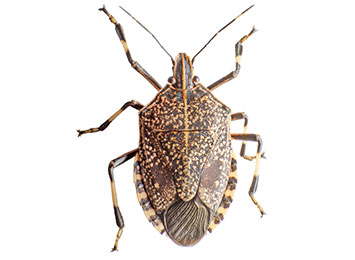What are stink bugs?
Stink bugs belong to the scientific order Hemiptera. The most common species is the Brown marmorated stink bug (Halyomorpha halys). Adult stink bugs are most active from spring to fall. In the spring they emerge from their overwintering spots hungry and ready to reproduce. In the fall they seek shelter from the cold or a safe place to hibernate such as your home.
What do stink bugs look like?
Stink bugs are approximately ⅝” long. They are “shield-shaped with a broad abdomen, six legs, and three body segments. Brown marmorated stink bugs are brown-grey with irregular black speckling, brown legs, white undersides, and white banding on their antennae and abodemns. Other stink bugs may be brown, gray, or dark green.


